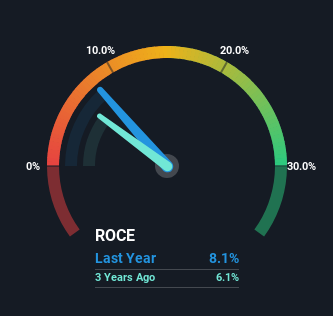Stock Analysis
- United States
- /
- Specialty Stores
- /
- NYSE:BURL
The Returns On Capital At Burlington Stores (NYSE:BURL) Don't Inspire Confidence

What trends should we look for it we want to identify stocks that can multiply in value over the long term? Ideally, a business will show two trends; firstly a growing return on capital employed (ROCE) and secondly, an increasing amount of capital employed. If you see this, it typically means it's a company with a great business model and plenty of profitable reinvestment opportunities. In light of that, when we looked at Burlington Stores (NYSE:BURL) and its ROCE trend, we weren't exactly thrilled.
What Is Return On Capital Employed (ROCE)?
Just to clarify if you're unsure, ROCE is a metric for evaluating how much pre-tax income (in percentage terms) a company earns on the capital invested in its business. To calculate this metric for Burlington Stores, this is the formula:
Return on Capital Employed = Earnings Before Interest and Tax (EBIT) ÷ (Total Assets - Current Liabilities)
0.081 = US$429m ÷ (US$7.0b - US$1.7b) (Based on the trailing twelve months to April 2023).
Therefore, Burlington Stores has an ROCE of 8.1%. Ultimately, that's a low return and it under-performs the Specialty Retail industry average of 13%.
See our latest analysis for Burlington Stores

Above you can see how the current ROCE for Burlington Stores compares to its prior returns on capital, but there's only so much you can tell from the past. If you're interested, you can view the analysts predictions in our free report on analyst forecasts for the company.
So How Is Burlington Stores' ROCE Trending?
When we looked at the ROCE trend at Burlington Stores, we didn't gain much confidence. Around five years ago the returns on capital were 30%, but since then they've fallen to 8.1%. However it looks like Burlington Stores might be reinvesting for long term growth because while capital employed has increased, the company's sales haven't changed much in the last 12 months. It's worth keeping an eye on the company's earnings from here on to see if these investments do end up contributing to the bottom line.
On a side note, Burlington Stores has done well to pay down its current liabilities to 25% of total assets. So we could link some of this to the decrease in ROCE. What's more, this can reduce some aspects of risk to the business because now the company's suppliers or short-term creditors are funding less of its operations. Since the business is basically funding more of its operations with it's own money, you could argue this has made the business less efficient at generating ROCE.
What We Can Learn From Burlington Stores' ROCE
To conclude, we've found that Burlington Stores is reinvesting in the business, but returns have been falling. Unsurprisingly, the stock has only gained 2.1% over the last five years, which potentially indicates that investors are accounting for this going forward. As a result, if you're hunting for a multi-bagger, we think you'd have more luck elsewhere.
One more thing to note, we've identified 1 warning sign with Burlington Stores and understanding it should be part of your investment process.
While Burlington Stores isn't earning the highest return, check out this free list of companies that are earning high returns on equity with solid balance sheets.
Valuation is complex, but we're helping make it simple.
Find out whether Burlington Stores is potentially over or undervalued by checking out our comprehensive analysis, which includes fair value estimates, risks and warnings, dividends, insider transactions and financial health.
View the Free AnalysisHave feedback on this article? Concerned about the content? Get in touch with us directly. Alternatively, email editorial-team (at) simplywallst.com.
This article by Simply Wall St is general in nature. We provide commentary based on historical data and analyst forecasts only using an unbiased methodology and our articles are not intended to be financial advice. It does not constitute a recommendation to buy or sell any stock, and does not take account of your objectives, or your financial situation. We aim to bring you long-term focused analysis driven by fundamental data. Note that our analysis may not factor in the latest price-sensitive company announcements or qualitative material. Simply Wall St has no position in any stocks mentioned.
About NYSE:BURL
Burlington Stores
Burlington Stores, Inc. operates as a retailer of branded merchandise in the United States.
Reasonable growth potential with proven track record.

